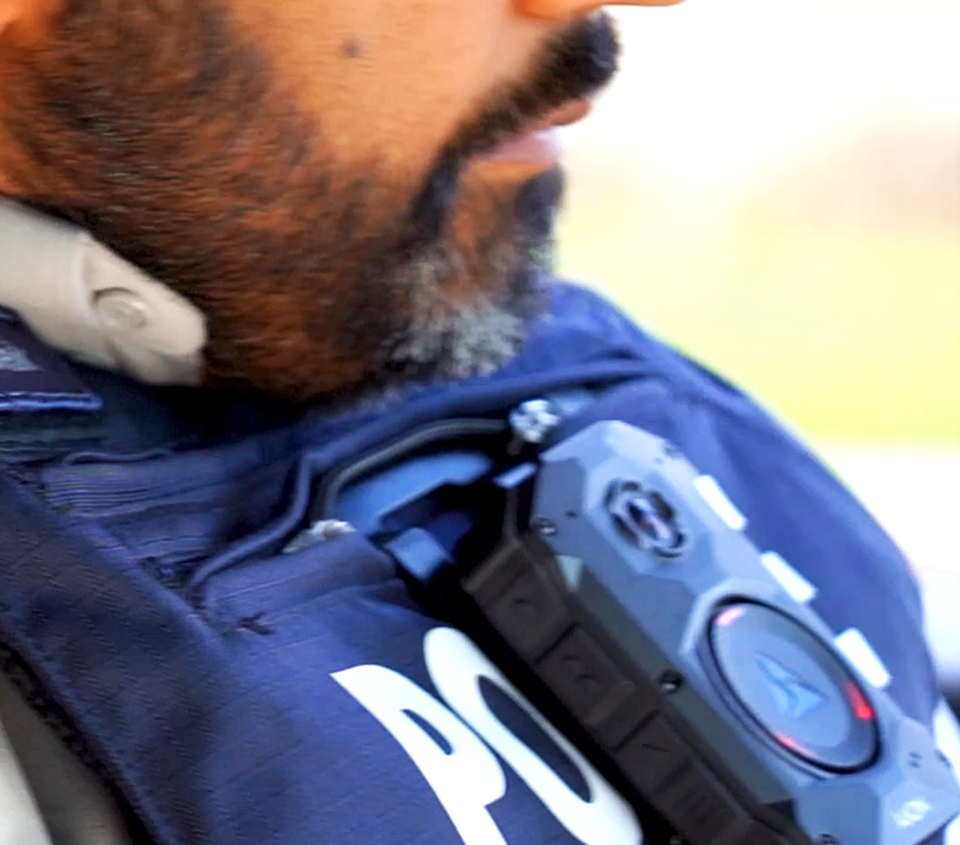Prince George RCMP officers started wearing body worn cameras on Dec. 8 and presented evidence from them to Crown counsel for the first time that evening, the city’s Standing Committee on Public Safety heard at its Tuesday, Dec. 17 meeting.
The meeting was the first time the committee has convened since local Mounties started wearing the cameras. Prince George is the first community in Northern BC to have its officers start to use the technology, with around 100 having been deployed so far.
The local officer in charge, Supt. Darin Rappel, passed one of the cameras around the conference table for attendees to look at.
He said it was the first casualty from among the new equipment after someone knocked it off an officer’s vest the previous day.
Joining Rappel for the presentation were Constables Jennifer Cooper and Chris Nichol.
Nichol had one of the cameras strapped to his vest. He showed that the camera could connect via wi-fi to his phone to show a live stream of footage.
While his camera was placed lower on his vest, he said there are different mounts that allow it to be placed higher on an officer’s body.
His phone was passed around the room so that attendees could see what his camera was capturing in real time.
The cameras are always capturing audio and video when on but aren’t saving that data unless activated. When an officer switches their camera on, it saves a 30-second buffer of soundless footage from before the activation and then starts recording live audio and video.
The camera unit flashes green when it is ready to record and flashes red when it is actively recording.
Cooper said that unlike Prince George, an issue with rolling out the cameras to other communities in Northern BC will be bandwidth.
To upload footage taken from one of the cameras to the cloud-based digital evidence management system, an officer has to put their unit into a docking station. No data connection is needed for the recording itself. They can record up to 60 hours of video, though most officers won’t record that much between uploads to the cloud.
Because of sometimes spotty internet connections in northern communities, the rollout in on hold until potential issues with uploading footage can be ironed out.
However, the units themselves are expected to function just fine in winter weather. They were tested in Nunavut and worked just fine. They can also be submerged in water up to a metre deep for a short time.
Once footage is uploaded, it is stored for a minimum of 30 days and longer if warranted by an investigation.
The mantra being drilled into officers with the equipment is “seatbelts off, camera on,” meaning that they their unit on when leaving their vehicle and entering what are referred to as “dynamic situations.”
However, the cameras aren’t to be used in all situations. Cooper said she wouldn’t turn it on if, for example, she was attending a school to give a talk.
Cameras are also to stay off when officers are undertaking a sensitive or intimate search of a detainee or if a detainee is changing their clothes after being arrested. Another area where they likely won’t be used is when officers make certain visits to medical facilities.
Once footage is uploaded to the cloud, it can’t be altered or edited unless an application is made to a supervisor. An example scenario is if, say, a detainee is accidentally filmed during an intimate search.
Cooper clarified that the primary purpose of the cameras is not for evidence gathering as most times, officers will arrive on scene after a crime has been committed. Instead, the intent is to provide transparency in officers’ dealings with the public and to help resolve public complaints into police conduct.
After the Calgary Police Service adopted body-worn cameras in 2019, Cooper said there was a 70 per cent reduction in public complaints.
Members of the public can request copies of footage they are in, but it has to be accessed through the federal Access to information and Privacy process.
“It’s not going to be like we see in the States where there is an exciting arrest or a dynamic chase and they pop that video up on YouTube right away or your social media feeds right away,” Cooper said.
“We won’t be throwing up video on social media very often for people to see. Only when there is an exceptional circumstance or to uphold public confidence in what happened. That would have to be under some serious review before we popped it up there.”
The $3,000 per year per member cost for each camera is for the camera itself, the software it runs on, the digital evidence management system, IT support and assistance with redacting and transcribing the recorded video.
Though the federal government put aside $238.5 million to help get body-worn cameras rolled out to police agencies in 2020, Coun. Cori Ramsay said at the meeting that this funding expired before municipalities actually started adopting them.
She said the Union of BC Municipalities is preparing a motion to make that money available to municipalities. Ramsay is not a member of the committee but sat in for the first half-hour of the meeting.
One of the reasons Rappel cited for the long time it took to implement the cameras was the maturity of the technology. He said that initially, the available technology did not capture audio and video of sufficient quality to meet the expectations of both police and the public.
He said the current units now meet those expectations and can even capture good quality video in low light conditions.


